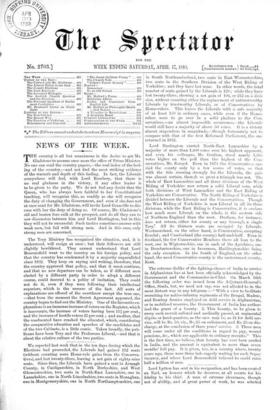We reported last week that in the ten days during
which the Elections had proceeded, the Liberals had gained 112 seats (without counting mere Home-rule gains from the Conserva- tives), and lost twenty-three, leaving a net gain of eighty-nine seats. Since then, the Liberals have gained a seat in Armagh County, in Cardiganshire, in North Derbyshire, and West Gloucestershire, two seats in North-East Lancashire, one in Lanarkshire, one in North Lincolnshire, two seats in Monaghan, one in Montgomeryshire, one in North Northamptonshire, one in South Northumberland, two seats in East Worcestershire, two seats in the Southern Division of the West Riding of Yorkshire ; and they have lost none. In other words, the total number of seats gained by the Liberals is F29; while they have lost twenty-three, showing a net gain of 106, or 212 on a divi- sion, without counting either the replacement of untrustworthy Liberals by trustworthy Liberals, or of Conservatives by Home-rulers. This leaves the Liberals with a safe majority of at least 150 in ordinary cases, while even if the home. rulerswere to go over in a solid phalanx to the Con- servatives,—an almost impossible occurrence,—the Liberals would still have a majority of above 50 votes. It is a victory almost stupendous in magnitude,—though fortunately not to compare with that of the first Reformed Parliament, the one returned in 1832.


































